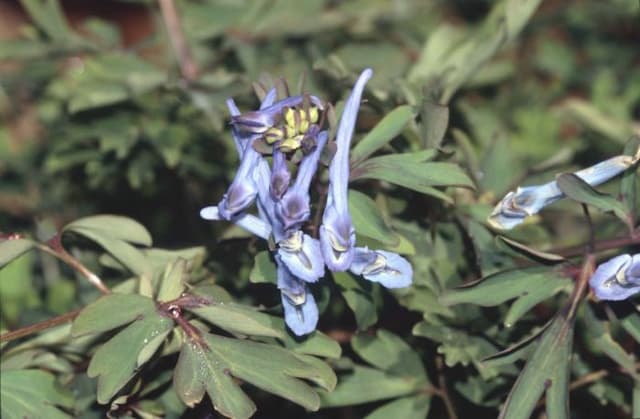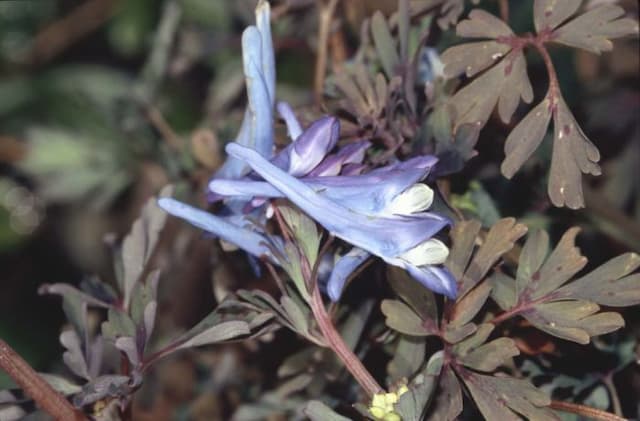Blue Poppy Meconopsis 'Marit'

ABOUT
Meconopsis 'Marit', commonly known as the Himalayan blue poppy, is a striking perennial that is prized for its beautiful flowers. It boasts large, satiny blooms that are most often a rich sky blue in color, though they can sometimes appear in shades of purple or red depending on the variety. The large, delicate petals form a cup-like shape, surrounding a cluster of prominent, bright yellow stamens that add a striking contrast to the bountiful blue blossoms. The plant typically bears deeply lobed leaves that are slightly hairy, creating a lush, textured green backdrop for the vivid flowers. The foliage often has a silvery green hue, adding to the plant's overall visual appeal. The leaves originate from a basal rosette, a cluster at the base of the stem, which gives the plant a neat, rounded habit. The blossoms are borne atop leafy stems that emerge from this central rosette. Even when not in bloom, the attractive foliage of the Himalayan blue poppy makes it a charming addition to any garden space that meets its specific growing requirements.
About this plant
 Names
NamesFamily
Papaveraceae
Synonyms
Marit Himalayan Blue Poppy, Marit Blue Poppy
Common names
Meconopsis 'Marit'
 Characteristics
CharacteristicsLife cycle
Perennials
Foliage type
Deciduous
Color of leaves
Green
Flower color
Blue
Height
2-3 feet (60-90 cm)
Spread
1-2 feet (30-60 cm)
Plant type
Herb
Hardiness zones
5
Native area
Himalayas
Benefits
 General Benefits
General Benefits- Aesthetic Appeal: Adds vibrant color and beauty to gardens with its striking blue flowers.
- Habitat Enrichment: Supports biodiversity by providing habitat and food for wildlife like bees and butterflies.
- Emotional Wellbeing: The presence of flowering plants like Blue Poppy can improve mood and reduce stress.
- Landscaping Versatility: Can be used in a variety of garden designs, from rock gardens to borders.
- Seasonal Interest: Offers a unique blooming pattern that can highlight different seasons in the garden.
 Medical Properties
Medical PropertiesThis plant is not used for medical purposes.
 Air-purifying Qualities
Air-purifying QualitiesThis plant is not specifically known for air purifying qualities.
 Other Uses
Other Uses- Textile Dyeing: Extracts from the petals of the Himalayan blue poppy have historically been used to create a natural dye for fabrics, offering hues ranging from blue to lilac.
- Culinary Decoration: The vibrant petals can be used as an edible garnish for salads and desserts, offering a striking pop of color, though they're not widely known for their flavor.
- Photography Props: Due to their unique and vivid coloration, these flowers often serve as subjects or backdrops in botanical and macro photography.
- Art Inspiration: The stunning visual appeal of the Himalayan blue poppy has inspired many artists to include its likeness in watercolor paintings, drawings, and textile patterns.
- Education and Research: These plants can be used for educational purposes to demonstrate the specific growth requirements of alpine plants in botanical gardens and universities.
- Garden Design: Himalayan blue poppies can be used as 'specimen plants' due to their striking appearance, around which a garden theme or design can be developed.
- Eco-Friendly Confetti: Dried petals of the flower could be used as a natural and biodegradable confetti for celebrations.
- Cultural Festivals: In areas where they grow natively, the bloom of this plant can mark the arrival of seasonal festivals or be incorporated in events as a symbol of the region's natural heritage.
- Relaxation and Mindfulness: Because of their rarity and beauty, spending time in a garden with Himalayan blue poppies can provide a peaceful environment conducive to relaxation and mindfulness practices.
- Bee Attraction: Although they are not known for their significant nectar or pollen production, they may still attract bees and other pollinators to the garden, benefiting the overall ecosystem.
Interesting Facts
 Feng Shui
Feng ShuiThe Blue Poppy is not used in Feng Shui practice.
 Zodiac Sign Compitability
Zodiac Sign CompitabilityThe Blue Poppy is not used in astrology practice.
 Plant Symbolism
Plant Symbolism- Rarity and Uniqueness: Meconopsis 'Marit', commonly known as the Blue Poppy, is a rare and unique plant, symbolizing the value of uniqueness and the pursuit of rarity. Its striking blue flowers are an uncommon sight in the plant world, making it a symbol for those things in life that are infrequent yet deeply treasured.
- Peace and Tranquility: The serene blue of the Blue Poppy is often associated with calmness and peace. It can symbolize the desire for tranquility in life or the presence of a peaceful state of mind.
- Dreams and Aspirations: The dreamlike quality of the Blue Poppy's blooms can represent aspirations, dreams, and the pursuit of personal goals. It's reminiscent of the sky and the sea, which are often linked to the boundless nature of dreams.
- Achievement of the Impossible: Blue Poppies are a symbol for achieving the seemingly impossible due to their fabled difficulty in cultivation. They represent triumph over challenges and the accomplishments that come through perseverance and dedication.
 Water
WaterFor optimal growth of the Himalayan Blue Poppy, consistent moisture is vital, especially during the growing season. Water the plant thoroughly, ensuring the soil is evenly moist but not waterlogged. An average watering frequency is about once a week, however, this may increase to twice a week during very hot or dry periods. A general guideline is to provide between one to two gallons of water per week, depending on weather conditions and soil drainage. It's best to water the plant in the early morning or late afternoon to reduce evaporation and give the plant time to absorb the moisture before nightfall.
 Light
LightHimalayan Blue Poppy thrives in dappled sunlight or in a spot with morning sun and afternoon shade. Direct, harsh sunlight can damage the delicate flowers and foliage, therefore, a position that receives filtered light or partial sun is ideal for this plant. Avoid placing it under a full sun exposure, especially in hotter climates, as this could cause stress and affect blooming.
 Temperature
TemperatureThe Himalayan Blue Poppy prefers cool conditions and does best in temperatures that range between 50 to 70 degrees Fahrenheit. This plant can survive minimum temperatures down to just below freezing, but it should be protected from severe frosts. During the summer, if the temperatures regularly exceed 70 degrees Fahrenheit, the plant may enter a period of dormancy; it is essential to provide it shade during these times.
 Pruning
PruningPruning the Himalayan Blue Poppy is required mostly to remove spent flowers and to maintain a tidy appearance. Deadheading, or the removal of faded flowers, encourages further blooming and prevents the plant from putting energy into seed production. Pruning can be done throughout the blooming season as flowers fade. The best time for general pruning is in the late fall as the plant dies back, at which point you can cut back the foliage to ground level.
 Cleaning
CleaningAs needed
 Soil
SoilThe Himalayan Blue Poppy (Meconopsis 'Marit') thrives best in a soil mix that is well-draining, rich in organic matter, and slightly acidic to neutral, with an ideal pH range of about 5.5 to 7. A mix containing equal parts of loam, peat, and perlite or sand can provide the right balance of drainage and fertility.
 Repotting
RepottingHimalayan Blue Poppies, including Meconopsis 'Marit', should be repotted every two to three years or when the plant outgrows its current container. This provides fresh nutrients and space for growing roots.
 Humidity & Misting
Humidity & MistingMeconopsis 'Marit', known as Himalayan Blue Poppy, prefers high humidity levels, ideally between 50% and 70%, to mimic its native mountainous environments.
 Suitable locations
Suitable locationsIndoor
Keep Meconopsis 'Marit' in cool conditions with indirect light and high humidity.
Outdoor
Plant in partial shade, moist soil, shelter from wind, and mulch well.
Hardiness zone
5-7 USDA
 Life cycle
Life cycleThe Meconopsis 'Marit', commonly known as Marit Himalayan Blue Poppy, begins its life cycle as a seed, which, once sown in fertile, well-drained soil and with adequate moisture, germinates to form a small seedling. The seedling develops into a rosette of leaves as it grows, establishing a strong root system. During its vegetative stage, the plant focuses on leaf growth and further root development, which can last for one to several years before it enters its flowering phase. Once mature enough to flower, usually in late spring or early summer, it produces tall flower stalks topped with stunning blue or blue-purple blooms that attract pollinators. After pollination, the plant sets seed, which ripen over the summer months and are then dispersed by wind or wildlife, completing the reproductive cycle. In some cases, Meconopsis 'Marit' behaves as a monocarpic species, dying after flowering and setting seed, but some plants can survive to bloom for more than one season.
 Propogation
PropogationPropogation time
Spring-Early Summer
Propogation: Meconopsis 'Marit', commonly known as Blue Poppy, is typically propagated by sowing seeds, which is the most popular method for this species. The ideal time for sowing seeds is in late winter to early spring, as Blue Poppies require a period of cold to break dormancy and germinate successfully. Fresh seeds should be sprinkled on top of a well-draining seed starting mix, then lightly covered with fine soil or vermiculite. The soil should be kept moist but not waterlogged, and the seed tray should be placed in a cool location with temperatures ranging from 50 to 60 degrees Fahrenheit (10 to 15.5 degrees Celsius). Germination usually occurs within 3 to 6 weeks, and once seedlings have developed their first true leaves, they can be carefully transplanted into individual pots. Seedlings should be protected from harsh conditions and gradually acclimatized to outdoor conditions before planting them out in their final location in the garden.









